星巴克logo英文介绍
- 格式:ppt
- 大小:8.42 MB
- 文档页数:24
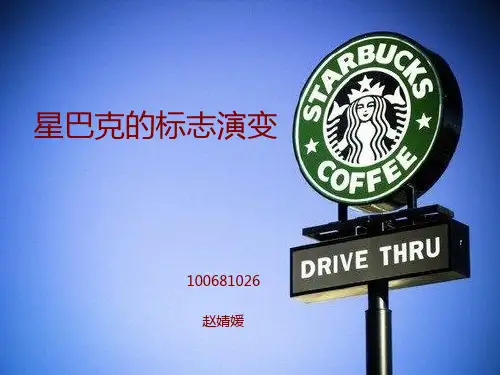
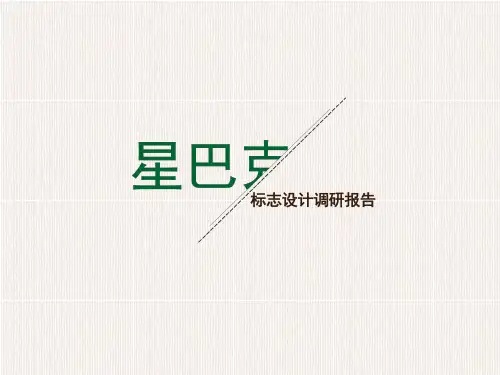
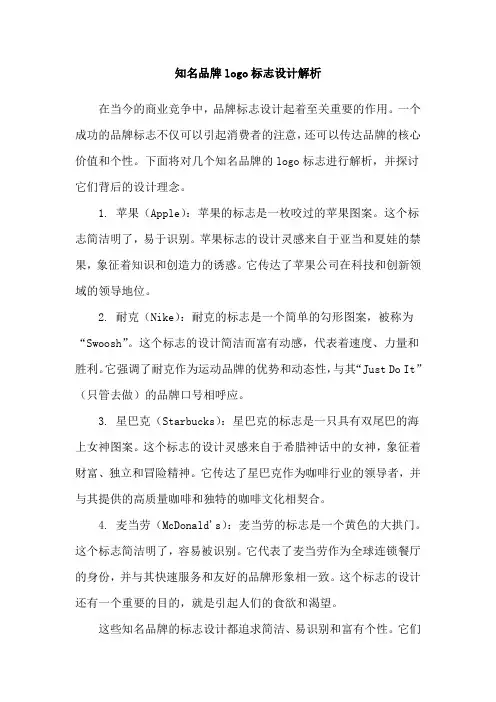
知名品牌logo标志设计解析在当今的商业竞争中,品牌标志设计起着至关重要的作用。
一个成功的品牌标志不仅可以引起消费者的注意,还可以传达品牌的核心价值和个性。
下面将对几个知名品牌的logo标志进行解析,并探讨它们背后的设计理念。
1. 苹果(Apple):苹果的标志是一枚咬过的苹果图案。
这个标志简洁明了,易于识别。
苹果标志的设计灵感来自于亚当和夏娃的禁果,象征着知识和创造力的诱惑。
它传达了苹果公司在科技和创新领域的领导地位。
2. 耐克(Nike):耐克的标志是一个简单的勾形图案,被称为“Swoosh”。
这个标志的设计简洁而富有动感,代表着速度、力量和胜利。
它强调了耐克作为运动品牌的优势和动态性,与其“Just Do It”(只管去做)的品牌口号相呼应。
3. 星巴克(Starbucks):星巴克的标志是一只具有双尾巴的海上女神图案。
这个标志的设计灵感来自于希腊神话中的女神,象征着财富、独立和冒险精神。
它传达了星巴克作为咖啡行业的领导者,并与其提供的高质量咖啡和独特的咖啡文化相契合。
4. 麦当劳(McDonald's):麦当劳的标志是一个黄色的大拱门。
这个标志简洁明了,容易被识别。
它代表了麦当劳作为全球连锁餐厅的身份,并与其快速服务和友好的品牌形象相一致。
这个标志的设计还有一个重要的目的,就是引起人们的食欲和渴望。
这些知名品牌的标志设计都追求简洁、易识别和富有个性。
它们通过独特的形象和符号传达品牌的核心理念和价值观。
成功的标志设计不仅可以帮助品牌在市场上脱颖而出,还可以建立品牌的声誉和认可度,为品牌的成功奠定基础。
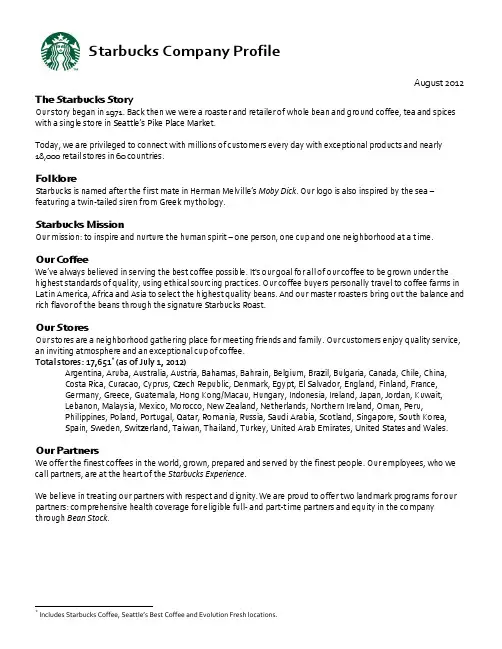
Starbucks Company ProfileAugust 2012The Starbucks StoryOur story began in 1971. Back then we were a roaster and retailer of whole bean and ground coffee, tea and spices with a single store in Seattle’s Pike Place Market.Today, we are privileged to connect with millions of customers every day with exceptional products and nearly 18,000 retail stores in 60 countries.FolkloreStarbucks is named after the first mate in Herman Melville’s Moby Dick. Our logo is also inspired by the sea – featuring a twin‐tailed siren from Greek mythology.Starbucks MissionOur mission: to inspire and nurture the human spirit – one person, one cup and one neighborhood at a time.Our CoffeeWe’ve always believed in serving the best coffee possible. It's our goal for all of our coffee to be grown under the highest standards of quality, using ethical sourcing practices. Our coffee buyers personally travel to coffee farms in Latin America, Africa and Asia to select the highest quality beans. And our master roasters bring out the balance and rich flavor of the beans through the signature Starbucks Roast.Our StoresOur stores are a neighborhood gathering place for meeting friends and family. Our customers enjoy quality service, an inviting atmosphere and an exceptional cup of coffee.Total stores: 17,651* (as of July 1, 2012)Argentina, Aruba, Australia, Austria, Bahamas, Bahrain, Belgium, Brazil, Bulgaria, Canada, Chile, China,Costa Rica, Curacao, Cyprus, Czech Republic, Denmark, Egypt, El Salvador, England, Finland, France,Germany, Greece, Guatemala, Hong Kong/Macau, Hungary, Indonesia, Ireland, Japan, Jordan, Kuwait,Lebanon, Malaysia, Mexico, Morocco, New Zealand, Netherlands, Northern Ireland, Oman, Peru,Philippines, Poland, Portugal, Qatar, Romania, Russia, Saudi Arabia, Scotland, Singapore, South Korea,Spain, Sweden, Switzerland, Taiwan, Thailand, Turkey, United Arab Emirates, United States and Wales.Our PartnersWe offer the finest coffees in the world, grown, prepared and served by the finest people. Our employees, who we call partners, are at the heart of the Starbucks Experience.We believe in treating our partners with respect and dignity. We are proud to offer two landmark programs for our partners: comprehensive health coverage for eligible full‐ and part‐time partners and equity in the company through Bean Stock.* Includes Starbucks Coffee, Seattle’s Best Coffee and Evolution Fresh locations.Starbucks Company ProfileOur ProductsStarbucks offers a range of exceptional products that customers enjoy in our stores, at home, and on the go. Coffee: More than 30 blends and single‐origin premium coffees.Handcrafted Beverages: Fresh‐brewed coffee, hot and iced espresso beverages, Frappuccino® coffee and non‐coffee blended beverages, smoothies and Tazo® teas.Merchandise: Coffee‐ and tea‐brewing equipment, mugs and accessories, packaged goods, music, books and gifts. Fresh Food: Baked pastries, sandwiches, salads, oatmeal, yogurt parfaits and fruit cups.Consumer Products•Coffee and Tea: Whole bean and ground coffee (Starbucks and Seattle’s Best Coffee brands), Starbucks VIA® Ready Brew, Starbucks® K‐Cup® portion packs, Tazo® tea filterbags and tea latte concentrates.•Ready‐to‐Drink (RTD): Starbucks® bottled Frappuccino® coffee drinks, Starbucks Discoveries® chilled cup coffees, Starbucks Doubleshot® espresso drinks, Starbucks Doubleshot® Energy+Coffee drinks; Seattle’s Best Coffee® Iced Lattes, Starbucks Refreshers™ beverages, Tazo® bottled iced and juiced teas.•Starbucks® Ice Cream: Super‐premium coffee and coffee‐free flavors.Brand PortfolioStarbucks Coffee, Seattle’s Best Coffee, Tazo Tea, Evolution Fresh, La Boulange and Torrefazione Italia Coffee.Investor Information•Starbucks went public on June 26, 1992 at a price of $17 per share (or $0.53 per share, adjusted for subsequent stock splits) and closed trading that first day at $21.50 per share.•Starbucks was incorporated under the laws of the State of Washington, in Olympia, Washington, on Nov. 4, 1985. •Starbucks Corporation's common stock is listed on NASDAQ, under the trading symbol SBUX.Being a Responsible CompanyAt Starbucks, we have always believed in the importance of building a great, enduring company that strikes a balance between profitability and a social conscience.Ethical Sourcing: We take a holistic approach to ethically sourcing the highest quality coffee. This includes responsible purchasing practices, supporting farmer loans and forest conservation programs. When we buy coffee this way, it helps foster a better future for farmers and a more stable climate for the planet. It also helps create a long‐term supply of the high‐quality beans we’ve been carefully blending, roasting and packing fresh for more than 40 years.Environmental Stewardship: We share our customers' commitment to the environment. And we believe in the importance of caring for our planet and encouraging others to do the same. It is our goal that by 2015, 100% of our cups will be reusable or recyclable. We will also work to significantly reduce our environmental footprint through energy and water conservation, recycling and green construction.Community Involvement: From the neighborhoods where our stores are located to the ones where our coffee is grown – we believe in fostering thriving communities. Bringing people together, inspiring change and making a difference in people’s lives – it’s all part of being a good neighbor. By 2015, we hope to contribute one million volunteer hours each year to our communities.Website© 2012 STARBUCKS COFFEE COMPANY. ALL RIGHTS RESERVED.。

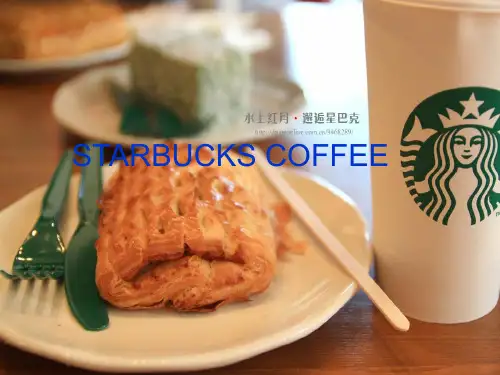
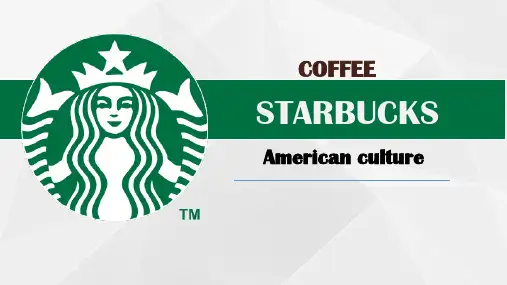
COFFEE STARBUCKS American cultureCOFFEEHistory in the 15th century.Arabia‘s Yemen :only source. The demand was very high, beans highly guarded.No fertile plants were allowed to leave the country. Muslim pilgrims(朝圣者)toMecca smuggled coffeeplants back to theirhomelands, and coffee cropssoon took root in India.Coffee also made its way toEurope through Venice, wherefleets traded perfumes, teas,dyes and fabrics with Arabicmerchants.Be popular when street vendorsbegan selling it.Green coffee beans are heated in a large rotating drum, then their transformation begins.After about 5 to 7 minutes, much of their moisture evaporates. The beans turn a yellow color and smell a little like popcorn. After about 8 minutes in the roaster, the "first pop" occurs. The beans double in size. They are now light brown.After 10-11 minutes, the beans reach an even brown color, and oil starts to appear on the surface of the bean.At this roasting time (between 11 and 15 minutes), the full flavor potential begins to develop in the beans, bringing all of their attributes into balance.The "second pop" signals that the coffee is almost ready. The smell of freshly roasted coffee fills the air.Baked Coffee BeansStarbucks Corporation, doing businessas Starbucks Coffee, is anAmerican coffee companyand coffeehouse chain based in Seattle,Washington.Founded in 1971, Starbucks is now thelargest coffeehouse company in the world, with 22,766stores in 65 countries and territories。
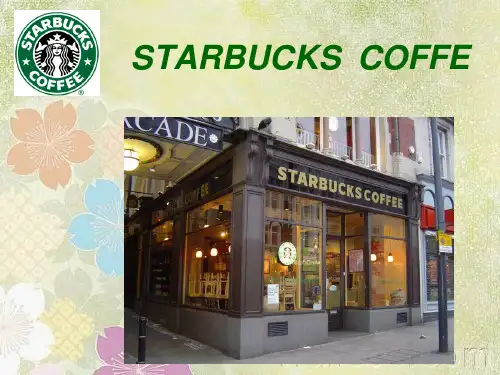
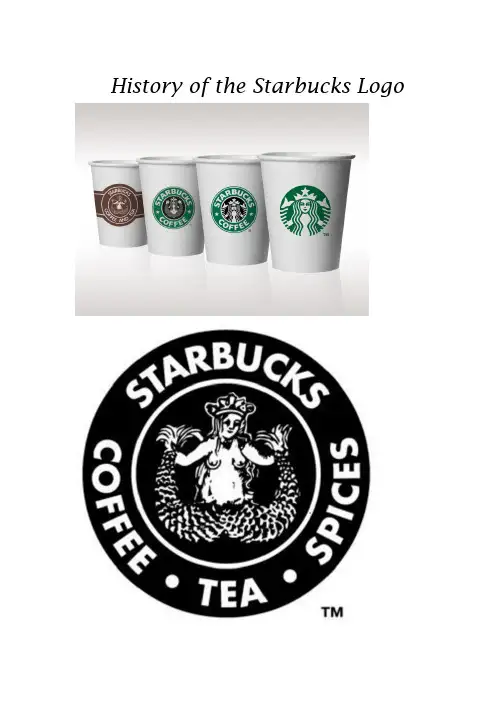
History of the Starbucks LogoWhen we were originally looking for a logo for Starbucks in 1971, we wanted to capture the seafaring tradition of early coffee traders. We pored over old marine books until we came up with a logo based on an old sixteenth-century Norse woodcut: a two-tailed mermaid encircled by the store's original name, Starbucks Coffee, Tea, and Spice.the siren, as you may recall from Greek mythology, was an alluring and irresistible female figure, typically half-fish/half-women (the mermaid variety). The siren's objective was to a seduce the seagoing mariner with a powerful enticing song most often to the unfortunate demise of the susceptible sailor who could not resist temptation.By 1992 Starbucks was experiencing a vast surge in popularity. With a wider cultural footprint and expanded global presence, an even more conservative rendition was produced, cropping in closer on the icon's face and away from her nether regions. This version would enjoy the longest run of their history and cement their place in the public mindshare.In 2011, the company revisited its brand, opting for even more simplicity by omitting the wordmark and outer border of their emblem. By this point their brand had become so recognizeable that a simple representation of the Siren in that unmistakeable green was all that was required for instant brand identification.With few rivals competing on their level and a concentrated effort on global brand awareness, Starbucks remains at the forefront of its industry. Their logo is an excellent illustration of how important storytelling is when it comes to building a brand or any great idea. Mythology is often a popular motif for this reason, but few legends could ever fit their business model quite like The Siren - that attractive vixen(坏女人) luring in unsuspecting sailors with a sweet song carriedon the wind. Today's modern commuters can relate as they zip from destination to destination, occasionally lured into a Starbucks by the fetching aroma(芳香)of their famous blends(调配,混合). Their successstory goes to show that like all masterpieces, the best brands oftenlook to life itself for inspiration.Conclusion of the evolutions of the logo of the starbucks coffee : from specific image to a kind of abstract image.So even people assume that the logo will carry on evolve like this:。
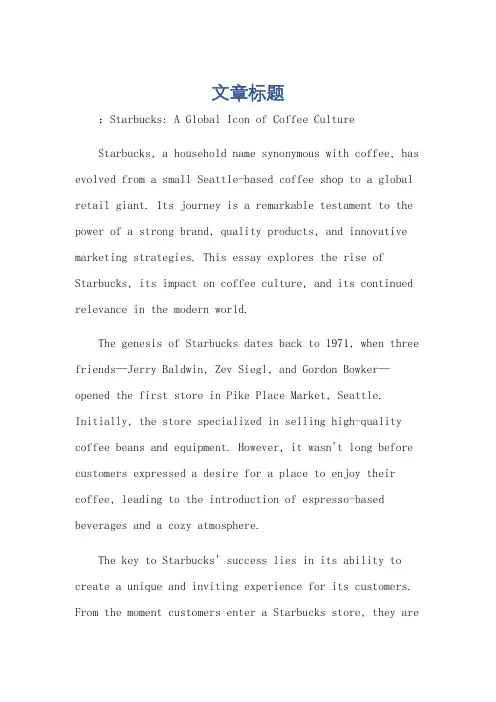
文章标题:Starbucks: A Global Icon of Coffee CultureStarbucks, a household name synonymous with coffee, has evolved from a small Seattle-based coffee shop to a global retail giant. Its journey is a remarkable testament to the power of a strong brand, quality products, and innovative marketing strategies. This essay explores the rise of Starbucks, its impact on coffee culture, and its continued relevance in the modern world.The genesis of Starbucks dates back to 1971, when three friends—Jerry Baldwin, Zev Siegl, and Gordon Bowker—opened the first store in Pike Place Market, Seattle. Initially, the store specialized in selling high-quality coffee beans and equipment. However, it wasn't long before customers expressed a desire for a place to enjoy their coffee, leading to the introduction of espresso-based beverages and a cozy atmosphere.The key to Starbucks' success lies in its ability to create a unique and inviting experience for its customers. From the moment customers enter a Starbucks store, they aregreeted by the familiar aroma of coffee, the cozy atmosphere, and the friendly staff. The store's interior design, often featuring warm tones and inviting seating areas, encourages customers to stay and enjoy their beverages. Additionally, Starbucks' commitment to using only the finest coffee beans and fresh ingredients ensures that each cup of coffee or beverage tastes exceptional.Another crucial aspect of Starbucks' success is its innovative marketing strategies. The company has always been at the forefront of leveraging technology to enhance the customer experience. For instance, the introduction of mobile ordering and payment options has made it easier for customers to order their favorite beverages on the go. Furthermore, Starbucks' loyalty program, which rewards customers with free drinks and other perks, has been a successful tool to increase customer retention and brand loyalty.Moreover, Starbucks has also capitalized on its brand recognition by expanding its product line to include a range of food items, merchandise, and even digital content. This diversification has not only broadened the company'srevenue streams but has also further strengthened its position as a lifestyle brand.The influence of Starbucks on coffee culture is undeniable. It has single-handedly revolutionized the way people consume and perceive coffee. Before Starbucks, coffee was often seen as a quick and utilitarian beverage. However, Starbucks transformed it into an experience, a ritual, and even a social activity. People now associate coffee with relaxation, conversation, and community, and Starbucks has been at the forefront of this cultural shift. In conclusion, Starbucks has become a global icon of coffee culture, thanks to its commitment to quality, innovative marketing strategies, and ability to create unique and inviting experiences for its customers. As the company continues to expand its reach and diversify its offerings, it remains a powerful example of how a brand can not only succeed commercially but also shape culture and influence people's lives.**星巴克:咖啡文化的全球象征**星巴克,这个与咖啡同名的家喻户晓的品牌,已经从西雅图的一家小咖啡店发展成为全球零售巨头。
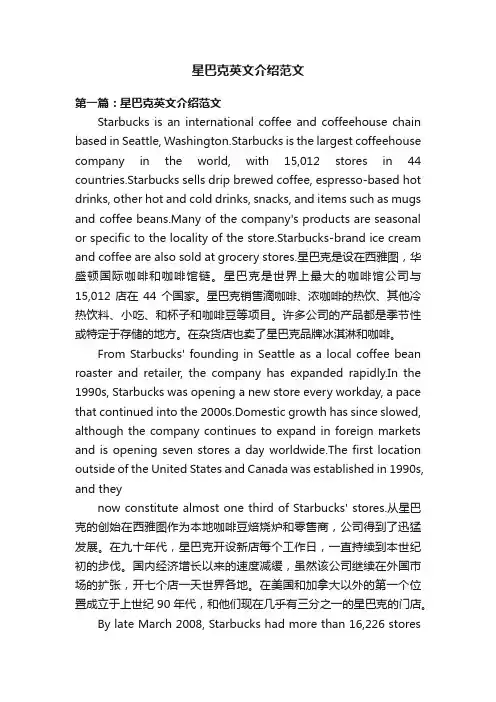
星巴克英文介绍范文第一篇:星巴克英文介绍范文Starbucks is an international coffee and coffeehouse chain based in Seattle, Washington.Starbucks is the largest coffeehouse company in the world, with 15,012 stores in 44 countries.Starbucks sells drip brewed coffee, espresso-based hot drinks, other hot and cold drinks, snacks, and items such as mugs and coffee beans.Many of the company's products are seasonal or specific to the locality of the store.Starbucks-brand ice cream and coffee are also sold at grocery stores.星巴克是设在西雅图,华盛顿国际咖啡和咖啡馆链。
星巴克是世界上最大的咖啡馆公司与15,012 店在44 个国家。
星巴克销售滴咖啡、浓咖啡的热饮、其他冷热饮料、小吃、和杯子和咖啡豆等项目。
许多公司的产品都是季节性或特定于存储的地方。
在杂货店也卖了星巴克品牌冰淇淋和咖啡。
From Starbucks' founding in Seattle as a local coffee bean roaster and retailer, the company has expanded rapidly.In the 1990s, Starbucks was opening a new store every workday, a pace that continued into the 2000s.Domestic growth has since slowed, although the company continues to expand in foreign markets and is opening seven stores a day worldwide.The first location outside of the United States and Canada was established in 1990s, and theynow constitute almost one third of Starbucks' stores.从星巴克的创始在西雅图作为本地咖啡豆焙烧炉和零售商,公司得到了迅猛发展。
星巴克logo的变迁(2011-07-18 17:07:20)转载▼标签:分类:《有味的PPT》美国星巴克美人鱼logo杂谈Starbucks的名字来自于白鲸记中爱喝咖啡的大副。
而是谁想到的这个名字就少有人知道。
这要追述到70年代初期,那个卖咖啡豆子以及香料的Starbucks。
Starbucks的名字实在是让星巴克的元老(三位)很是费心,Gordon Bowker与他的创意伙伴艺术家Terry Heckler 商量店名,他其实想要用“Pequod”这个名字,这个词来源于白鲸记中的那艘船。
Terry Heckle 不同意这个意见他想要的是一个与众不同而又可以同美国西北部有关系的店名,他选中了雷尼尔山附近矿工聚集地的名字“Starbo”,又经过商量Gerald Baldwin重新把名字同他喜爱的白鲸记拉上关系,Starbuck就是Pequod号上的爱喝咖啡的大副。
Howard Schultz在自己的书中说这个名字让人想起了海上的冒险故事,也让人回忆起早年咖啡商人遨游四海寻找好咖啡豆的传统,多少有些饮水思源的寓意。
星巴克的标志颇具神秘色彩,据说名字定下后,Terry Heckle开始研究其古老的海事书籍,后来找到了一幅16世纪斯堪的纳维亚Scandinavia的双尾美人鱼木雕(版画)图案,于是设计出了星巴克的标志,也就是美人鱼在中间周围围绕着STARBUCKS COFFEE TEA SPICES的字样,据查,这个标志首次使用是在1971年的3月29日。
1971 - 1987,公司最早的logo当时的星巴克公司名称为:Starbuck’s Coffee Company(Washington corporation)注册地址为2200 W.Emerson Place Seattle,Wash.98199后来在1986年的11月18日注册了仅有STARBUCKS字样的这个标志,美人鱼的样子基本上没有变化,1989年的6与6日所注册的商标(可能之前就已经在应用)有很大的改变,颜色换成了绿色,美人鱼依然是全身像,依然保留了肚脐眼儿,但脱离了版画的风格,而更像个标志了。